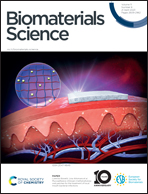3D printable acrylate polydimethylsiloxane resins for cell culture and drug testing†
Abstract
Nowadays, most of the microfluidic devices for biological applications are fabricated with only few well-established materials. Among these, polydimethylsiloxane (PDMS) is the most used and known. However, it has many limitations, like the operator dependent and time-consuming manufacturing technique and the high molecule retention. TEGORad or Acrylate PDMS is an acrylate polydimethylsiloxane copolymer that can be 3D printed through Digital Light Processing (DLP), a technology that can boast reduction of waste products and the possibility of low cost and rapid manufacturing of complex components. Here, we developed 3D printed Acrylate PDMS-based devices for cell culture and drug testing. Our in vitro study shows that Acrylate PDMS can sustain cell growth of lung and skin epithelium, both of great interest for in vitro drug testing, without causing any genotoxic effect. Moreover, flow experiments with a drug-like solution (Rhodamine 6G) show that Acrylate PDMS drug retention is negligible unlike the high signal shown by PDMS. In conclusion, the study demonstrates that this acrylate resin can be an excellent alternative to PDMS to design stretchable platforms for cell culture and drug testing.



 Please wait while we load your content...
Please wait while we load your content...